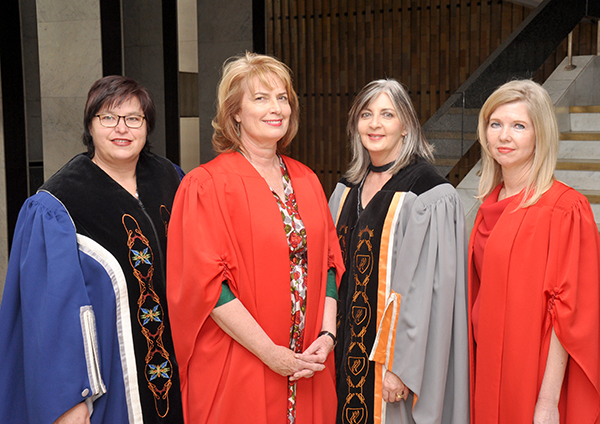
At Prof Naòmi Morgan’s inaugural lecture were, from the left:
Profs Corli Witthuhn, Vice-Rector: Research; Morgan;
Heidi Hudson, Acting Dean of the Faculty of the Humanities;
and Angelique van Niekerk, Head of the Department of Afrikaans
and Dutch, German and French.
Photo: Stephen Collett
Translation is normally done from a so-called weaker language into a mightier one. This is one of the ways, according to author Antjie Krog in her book A Change of Tongue, which is used by a ‘weaker’ language to help it survive.
However, according to Prof Naòmi Morgan, Head of French in the Department of Afrikaans and Dutch, German and French at the University of the Free State (UFS), this is not the case with French, which is the mightier language, and Afrikaans.
Influence of translators on Afrikaans
“The number of translated titles from French into Afrikaans, from ‘great’ into ‘lesser’ language, is far more than the other way round, almost as if the translators wanted to make the Afrikaans-speaking readers literary self-sufficient, but did not feel the same need to extend the Afrikaans literature into other languages.”
This was Prof Morgan’s words on 8 November 2017 during her inaugural lecture entitled, Van Frans na Afrikaans: 100 jaar van byna eenrigting-vertaalverkeer, in the Equitas Auditorium on the Bloemfontein Campus. A PowerPoint presentation, with a symbolic background of the South African and French flags and relevant texts, formed part of her lecture. She also played video clips and pieces of music to complement it.
Among others, she has a doctorate in Modern French Literature from the University of Geneva, and her translations have earned her a French Knighthood and various prizes. She is also well-known for her translations and involvement in dramas such as Oskar en die Pienk Tannie and Monsieur Ibrahim en die blomme van die Koran.
Greater challenges in this direction
In her lecture, she looked at the two-way traffic from French into Afrikaans and from Afrikaans into French.
Three French citizens, Pierre-Marie Finkelstein, Georges Lory, and Donald Moerdijk, have translated from Afrikaans into French. Of course, their background and ties with South Africa also had an influence on their work. “In Moerdijk’s case, translation from Afrikaans, his second language, was a way in which to recall the country he left in his mind’s eye,” she said.
Prof Morgan is one of only two translators who translates works from Afrikaans into French, the other being Catherine du Toit. However, translations in this direction pose greater challenges. She said it involves “not only knowledge of the language, but also knowledge of the French target culture and literature”. In addition, there aren’t any good bilingual dictionaries, and the only Afrikaans-French dictionary is a thin volume by B Strelen and HL Gonin dating from 1950.
Prof Morgan still believes in translation
She believes there is a need to hear foreign languages such as French in the form of music in Afrikaans, and the speaking of a language alone might not be enough to ensure its survival.
She still believes in translation, and quoted Salman Rushdie’s Imaginary homelands: essays and criticism 1981-1991 in this respect: “The word ‘translation’ comes, etymologically, from the Latin for ‘bearing across’. Having been borne across the world, we are translated men. It is normally supposed that something always gets lost in translation; I cling, obstinately to the notion that something can also be gained.”
Click here for Prof Morgan’s full lecture (only available in Afrikaans).